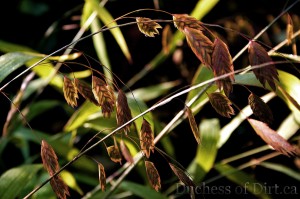Euphorbia amygdaloides ‘Purpurea’
 Euphorbia amygdaloides ‘Purpurea’
Euphorbia amygdaloides ‘Purpurea’
(yew-FOR-bee-ah ah-mig-dah-LOY-deez
per-per-EE-ah)
syn. Euphorbia amygdaloides ‘Rubra’
Family: Euphorbiacaea
Common name: wood spurge; purple wood spurge
Zone: 5 – 9
Height: 12 – 18 in (30 – 45cm)
Spread: 12 in (30cm)
Aspect: full sun; partial shade; full shade
Soil: average; well-draining
Water: minimal
 Description: An evergreen perennial with an upright, bushy habit. Stems and lanceolate leaves are a handsome burgundy-purple colour which show off the clusters of bright greenish-yellow flower bracts to perfection in mid-spring through early summer. Foliage changes to purple-black in winter.
Description: An evergreen perennial with an upright, bushy habit. Stems and lanceolate leaves are a handsome burgundy-purple colour which show off the clusters of bright greenish-yellow flower bracts to perfection in mid-spring through early summer. Foliage changes to purple-black in winter.
Special Notes: Flowers on old wood. Prune plants back after flowering. Good cut flower but stem tips must be singed or dipped in boiling water to stop the milky sap from flowing.
Drought tolerant. Deer and rabbit resistant but may be susceptible to aphids. Watch for powdery mildew or grey moulds which would indicate too much moisture or poor air circulation. Propagate by seed or by division in spring or autumn.
Caution: Potential to become a nuisance if spent flowers are not removed before seeds mature or by regularly dividing the plant every few years to keep the rhizomes from spreading beyond the boundary you set for this lovely plant.
Milky sap can cause skin and eye irritation. Toxic if ingested. Wear gloves when handling. Protective eye equipment is recommended.
In our Zone 7a garden: We find this plant quietly adds its charm to the garden display with a minimum of fuss and bother.
The Duke of Compost adds: Be sure to water this plant regularly during heat waves, especially if you have placed it in full sun. It is only drought tolerant up to a point.
Posted on March 7, 2013; updated on April 22, 2025
Epimeduim x versicolor ‘Sulphureum’
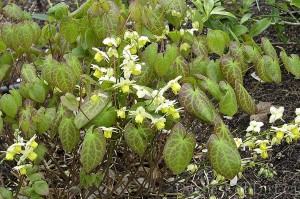 Epimedium x versicolor ‘Sulphureum’
Epimedium x versicolor ‘Sulphureum’
(ep-ih-MEE-dee-um x VUR-sih-kull-ur)
Family: Berberidacaea
Common name: yellow barrenwort; yellow bishop’s hat
Zone: 5 – 9
Height: 12 – 15 in (30 – 38cm)
Spread: 12 in (30cm)
Aspect: partial shade; full shade
Soil: fertile; humus-rich; well-draining
Water: moderate
Description: An evergreen perennial with a mounding, slow spreading habit. Pale yellow, bishop hat-shaped flowers appear at the top of spurs in mid- through late spring. Heart-shaped, dark green leaflets are flushed a deep bronze-red colour when they first appear during the flowering period, gradually losing this flush as the season progresses. Leaves form a very pleasing evergreen mound.
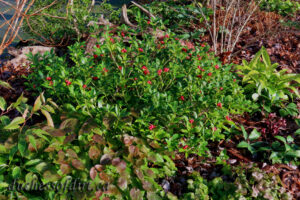 Special Notes: Hybrid seedling of E. grandiflorum x E. pinnatum subsp. cochicum. This plant is valued for its ability to thrive and prosper amongst the tough roots of mature trees. Needs fertile soil and regular watering during the hot summer periods when planted in full sun. Flower production will not be as vigorous and winter foliage colour will be compromised if planted in full shade. Cut leaves back in early February to view the flowers and allow for fresh new growth. Fresh plant divisions will take up to two years to establish. Propagate by division in autumn.
Special Notes: Hybrid seedling of E. grandiflorum x E. pinnatum subsp. cochicum. This plant is valued for its ability to thrive and prosper amongst the tough roots of mature trees. Needs fertile soil and regular watering during the hot summer periods when planted in full sun. Flower production will not be as vigorous and winter foliage colour will be compromised if planted in full shade. Cut leaves back in early February to view the flowers and allow for fresh new growth. Fresh plant divisions will take up to two years to establish. Propagate by division in autumn.
Royal Horticultural Society Award of Garden Merit (AGM) 1993
Posted on March 7, 2013; updated on April 2, 2025
Epimedium x rubrum
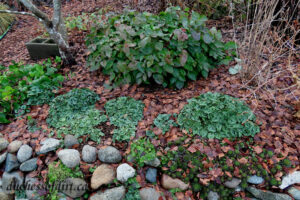 Epimedium x rubrum
Epimedium x rubrum
(ep-ih-MEE-dee-um x ROO-brum)
Family: Berberidacaea
Common name: red barrenwort; red bishop’s hat; fairy wings
Zone: 5 – 9
Height: 12 – 15 in (18 – 38 cm)
Spread: 12 – 24 in (18 – 60 cm)
Aspect: partial to full shade
Soil: fertile; humusy; well-draining
Water: moderate
 Description: A semi-evergreen perennial with a mounding, slowly spreading habit. Red, bishop hat-shaped flowers appear at the top of spurs in mid- through late spring. Heart-shaped, dark green leaflets are flushed a deep bronze-red colour when they first appear during the flowering period, gradually losing the red flush as the season progresses. Leaves form a very pleasing evergreen mound.
Description: A semi-evergreen perennial with a mounding, slowly spreading habit. Red, bishop hat-shaped flowers appear at the top of spurs in mid- through late spring. Heart-shaped, dark green leaflets are flushed a deep bronze-red colour when they first appear during the flowering period, gradually losing the red flush as the season progresses. Leaves form a very pleasing evergreen mound.
Special Notes: Hybrid seedling from E. alpinum and E. grandiflorum. This plant is valued for its ability to thrive and prosper amongst the tough roots of mature trees. Cut the leaves back in late winter in order to view the fresh flush of flowers and allow for fresh new foliage growth to develop. Fresh plant divisions will take up to two years to settle in. Propagate by division in autumn. Good pest and disease resistance. Deer and rabbit resistant.
In our Zone 7a garden: We have found this plant does well in mediocre soil and deep shade, holding its own against tree and shrub roots…although a top dressing of soil amendment in early spring keeps our plants flourishing nicely. Nothing seems to affect this plant species with the exception of an occasional problem with leaf cutter bees taking small, crescent moon-shaped cuts out of some leaf edges.
Royal Horticultural Society Award of Garden Merit (AGM) 1993; Great Plant Pick 2005
Posted on March 7. 2013; updated April 2, 2025
Choisya x dewitteana ‘Aztec Pearl’
 Choisya x dewitteana ‘Aztec Pearl’
Choisya x dewitteana ‘Aztec Pearl’
(CHOY-zee-ah duh-wit-ee-AY-nuh)
Family: Rutaceae
Common name: Mexican mock orange; Mexican orange blossom
Zone: 7 – 10
Height: 8 ft (2.5m)
Spread: 8 ft (2.5m)
Aspect: full sun; partial shade
Soil: fertile; well-draining
Water: regular
Description: An evergreen, dense, rounded shrub. Aromatic, glossy, bright yellow-green leaves made up of three oblong leaflets. Clusters of fragrant, star-shaped, creamy white flowers appear in late spring. There may be a second flowering in autumn.
Special Notes: A cross between Choisya ternata and Choisya dumosa var. arizonica bred by Peter Moore of Hilliers Nurseries in 1982. This cultivar was the first hybrid in the genus and named for the French nurseryman, Dominique de Witte.
Needs some protection in Zone 7. Will tolerate seaside conditions but not direct exposure to salty winds. Prune into shape after flowering. Leaves will be more golden yellow if grown in full sun. Propagate by softwood cuttings in late spring; hardwood cuttings in autumn.
In our Zone 7a garden: Choisya x dewitteana ‘Aztec Pearl’ resides under the eave on the right corner at the front of the house. The eave provides protection when our winter temperatures dip to -12 °C (10.4 °F) and lower some years. ‘Aztec Pearl’ is also protected in that spot from the prevailing SE winds which seem to be getting increasingly stronger each year.
RHS Award of Garden Merit 1993
Posted on January 17, 2013; updated on January 15, 2025
Chasmanthium latifolium
 Chasmanthium latifolium
Chasmanthium latifolium
(kaz-MAN-thi-um lat-ih-FOE-lee-um)
Family: Poaceae
Common name: Northern sea oats, river oats
Zone: 3 – 8
Height: 3 – 4 ft (90 – 120 cm)
Spread: 2 – 3 ft (60 – 90 cm)
Aspect: Full sun; part shade; full shade
Soil: moist, fertile, well-drained
Water: average
Description: Clump-forming grass with light green lanceolate, bamboo-like foliage. Blades are 10 – 12 inches (25 – 30 cm) long and one-inch (2.5 cm) wide. The above ground stems (called culms) support showy, spike-like panicles above the leaves. Each panicle consists of 7 – 20 flat, green-tinged spikelets. Each individual spikelet is one-inch (2.5 cm) long, flat in appearance and scaly.
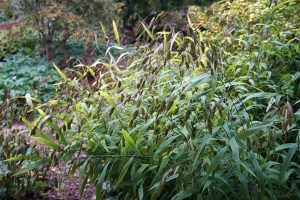 Special Notes: Native from the midwestern to eastern parts of the United States, this ornamental grass is one of the most drought and shade tolerant. While it prefers fertile soil conditions, it will thrive in all soils types and moisture conditions. Wonderful understory plant with an added benefit that it is tolerant of the toxic chemical juglone produced by black walnut (Juglan nigra) trees. Good coppery-brown fall colour in both foliage and seedheads.
Special Notes: Native from the midwestern to eastern parts of the United States, this ornamental grass is one of the most drought and shade tolerant. While it prefers fertile soil conditions, it will thrive in all soils types and moisture conditions. Wonderful understory plant with an added benefit that it is tolerant of the toxic chemical juglone produced by black walnut (Juglan nigra) trees. Good coppery-brown fall colour in both foliage and seedheads.
Plant host to some caterpillars, particularly of the Northern Pearly Eye butterfly, and skipper species. Provides cover for birds and seeds for small mammals. Good plant for containers, in mass plantings and for erosion control. Excellent in dried flower arrangements and good winter interest. Deer resistant.
Posted on November 8, 2023; Updated on January 7, 2025
